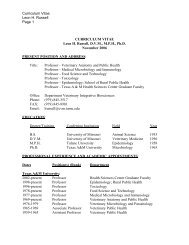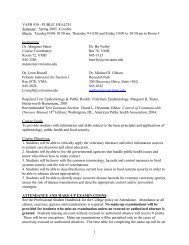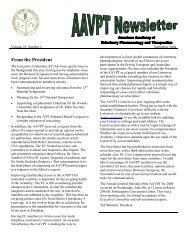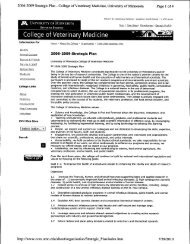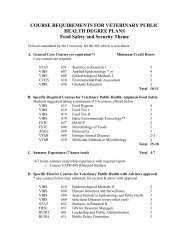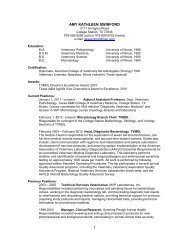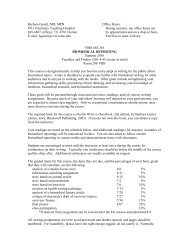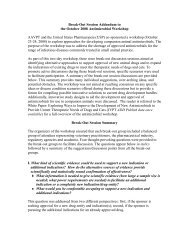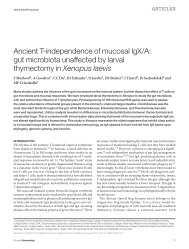Disaster - College of Veterinary Medicine - Texas A&M University
Disaster - College of Veterinary Medicine - Texas A&M University
Disaster - College of Veterinary Medicine - Texas A&M University
You also want an ePaper? Increase the reach of your titles
YUMPU automatically turns print PDFs into web optimized ePapers that Google loves.
Faculty/Staff Focus<br />
H<strong>of</strong>fman honored with student-selected teaching award<br />
Dr. Anton G. H<strong>of</strong>fman, clinical<br />
pr<strong>of</strong>essor in the Department <strong>of</strong> <strong>Veterinary</strong><br />
Integrative Biosciences (VIBS) <strong>of</strong><br />
the <strong>Texas</strong> A&M <strong>University</strong> <strong>College</strong> <strong>of</strong><br />
<strong>Veterinary</strong> <strong>Medicine</strong> & Biomedical Sciences<br />
(CVM), has been honored with<br />
a student-selected Teaching Excellence<br />
Award.<br />
Initiated by Chancellor Michael<br />
D. McKinney in 2008, the Teaching<br />
Excellence Awards program honors<br />
and financially rewards top teachers<br />
throughout the 11 branch campuses<br />
<strong>of</strong> the <strong>Texas</strong> A&M <strong>University</strong> System<br />
for excellence in classroom teaching.<br />
Awards are based solely on rankings<br />
from evaluations created and administered<br />
by students, with weighting for<br />
factors such as class size. All A&M system<br />
faculty members who teach at least<br />
a three-hour course can participate in<br />
this program.<br />
“This program allows students<br />
to recognize the many outstanding<br />
teachers that we have across the A&M<br />
System,” said McKinney. “While we are<br />
proud to extend our financial appreciation<br />
to these faculty members, these<br />
awards are about giving credit to those<br />
who give their best each day for their<br />
students, and ultimately to the state <strong>of</strong><br />
<strong>Texas</strong>.”<br />
Ranked in the top five percent <strong>of</strong> the<br />
total 207 <strong>Texas</strong> A&M <strong>University</strong> System<br />
faculty winners, H<strong>of</strong>fman will be one<br />
<strong>of</strong> three faculty members to receive a<br />
check for $10,000, the highest amount<br />
awarded.<br />
“I am honored and humbled to<br />
receive the Chancellor’s Teaching Excellence<br />
Award,” H<strong>of</strong>fman said. “I can<br />
honestly say that my teaching career<br />
has been more challenging, stimulating,<br />
and rewarding than I could have<br />
ever imagined. It is a joy to watch<br />
veterinary students grow and mature<br />
during their short time with us, both<br />
intellectually and personally. It is incredibly<br />
rewarding to me when my students<br />
come back to me after the third<br />
or fourth year or even post-graduation<br />
and say ‘thanks,’ ‘thanks for taking the<br />
time to help,’ ‘thanks for caring about<br />
whether I understood the material’.”<br />
The award is a noteworthy addition<br />
to the string <strong>of</strong> teaching honors H<strong>of</strong>fman<br />
has received during his career.<br />
These include the John H. Millif Award<br />
for Teaching, the Carl J. Norden/<br />
Pfizer Distinguished Teacher Award<br />
(which he has won twice), the Association<br />
<strong>of</strong> Former Students Distinguished<br />
Achievement Award for teaching (at<br />
both the college and university levels)<br />
and the university-level Student Led<br />
Award for Teaching Excellence.<br />
A 1986 graduate <strong>of</strong> the CVM, H<strong>of</strong>fman<br />
joined the department <strong>of</strong> veterinary<br />
anatomy and public health (now<br />
VIBS) in 1987 as a veterinary clinical<br />
associate. He was promoted to senior<br />
lecturer in 1998, clinical associate<br />
pr<strong>of</strong>essor in 2003, and since 2009, he<br />
has served in the position <strong>of</strong> clinical<br />
pr<strong>of</strong>essor.<br />
H<strong>of</strong>fman’s main responsibilities involve<br />
teaching a range <strong>of</strong> undergraduate<br />
and pr<strong>of</strong>essional anatomy courses<br />
<strong>of</strong>fered by the VIBS department. These<br />
include a comprehensive small animal<br />
gross anatomy course taught in the first<br />
semester <strong>of</strong> the pr<strong>of</strong>essional program;<br />
a special programs course in which<br />
biomedical science undergraduate<br />
students can work on anatomic projects<br />
such as skeletal preparation; and a<br />
neuroanatomy and clinical neurology<br />
course, which teaches not only anatomy<br />
<strong>of</strong> the gross brain and spinal cord, but<br />
also focuses heavily on neurological<br />
examination and localization <strong>of</strong> neurological<br />
lesions.<br />
“For most students, the thought <strong>of</strong><br />
an anatomy course can be quite scary,”<br />
H<strong>of</strong>fman said, explaining his teaching<br />
style. “However, it has been my observation<br />
that they will usually dive into the<br />
material once they [are motivated] and<br />
have a clear sense <strong>of</strong> the usefulness <strong>of</strong><br />
the material to their future careers.<br />
To that end, I try to keep my anatomy<br />
courses clinically relevant by emphasizing<br />
major points with various ‘realworld’<br />
clinical examples.”<br />
H<strong>of</strong>fman also believes in developing<br />
innovative methods to cater to different<br />
learning styles. He has facilitated<br />
student learning by developing computer<br />
s<strong>of</strong>tware programs for teaching anatomy,<br />
for example, Canine Radiographic<br />
Anatomy (<strong>Texas</strong> A&M <strong>University</strong> Press).<br />
Also, as director <strong>of</strong> the department’s<br />
Plastination Laboratory since 1994,<br />
he has developed plastinated models<br />
for teaching. Further, as a medical illustrator,<br />
he has contributed numerous<br />
anatomic illustrations to peer-reviewed<br />
manuscripts, books, book chapters<br />
and presentations. H<strong>of</strong>fman has also<br />
prepared anatomical illustrations for<br />
the courses he teaches to aid student<br />
learning.<br />
“A teacher is one who makes himself<br />
progressively unnecessary,” is one <strong>of</strong><br />
H<strong>of</strong>fman’s favorite teaching quotes and<br />
one that defines his teaching philosophy.<br />
By not only imparting information<br />
but also by teaching his students how<br />
to find information, learn on their own<br />
and ask questions, H<strong>of</strong>fman hopes that<br />
ultimately, his students will get along<br />
without him, not even noticing if he’s<br />
not around.<br />
Dr. Anton G. H<strong>of</strong>fman with a student, Eliab Chavira, in the anatomy lab at the CVM.<br />
CVM Today • Summer 2010 • 39




